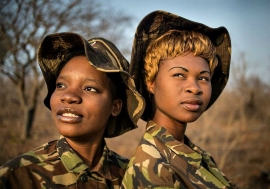Elephants are the latest conflict resource
An average of about 45 elephants per day were illegally killed in 2011 in every two of five protected sites holding elephant populations in Africa, thanks to the growing illegal trade in ivory, which continues to threaten the survival of elephants on the continent. A joint report by four international conservation organizations says that 17,000 elephants were killed in 2011 alone and the amount of ivory seized has tripled over the last decade.
“Organized criminal networks are cashing in on the elephant poaching crisis, trafficking ivory in unprecedented volumes and operating with relative impunity and with little fear of prosecution,” says Tom Milliken, an expert on ivory trade with TRAFFIC, a global wildlife trade monitoring network.
The joint report, Elephants in the Dust: The African Elephant Crisis, released this year, warns that increasing poaching levels, as well as loss of habitat, are threatening the survival of African elephant populations in Central Africa and in previously secure populations in West, Southern and Eastern Africa. The report was produced by the UN Environment Programme (UNEP), the Convention on International Trade in Endangered Species (CITES), the International Union for Conservation of Nature (IUCN) and the Wildlife Trade Monitoring Network (TRAFFIC).
The 17,000 elephants illegally killed in 2011 lived at sites monitored through the CITES-led Monitoring Illegal Killing of Elephants programme these sites hold approximately 40% of the total elephant population in Africa. The report warns that initial data from 2012 show that the situation had not improved, and that the true figures may be much higher.
Long ago elephants used to roam freely in Africa, finding paradise in places like Côte d’Ivoire, which literally means “the coast of ivory.” Even the country’s national football team, Les Éléphants, derives its name from the mighty animal. The elephant population of Côte d’Ivoire has since dropped dramatically, with only about 800 remaining throughout the country. The drive to save elephants has become the latest frontier in the conflict over natural resources in Africa.
“Like blood diamonds from Sierra Leone or plundered minerals from Congo, ivory, it seems, is the latest conflict resource in Africa, dragged out of remote battle zones, easily converted into cash and now fueling conflicts across the continent,” according to Jeffrey Gettleman of the New York Times.
Elephant tusks are of high value in the Far East, particularly in China, Vietnam, the Philippines and Malaysia, where many use them for ornamentation as well as for religious purposes. With booming economies, the demand can only increase, many believe.
Going extinct
Increasing numbers of poachers in Africa are ready to supply these markets. They slaughter the animals and saw off their tusks, sometimes even invading sanctuaries to do so. Given the rate at which they are being slaughtered each year, African elephants could be extinct over the next decade, says the Wildlife Conservation Society, an animal protection organization.
The authors of Elephants in the Dust agree. They say current population estimates suggest alarming declines in elephant numbers in parts of Central and West Africa, as well as an increasing risk of extinction for some local populations. Africa used to have a few million elephants at the turn of the century, current estimates put the continental population in the range of 420,000 to 650,000. Botswana, Tanzania and Zimbabwe account for well over half of them.
Cyanide poisoning
Worse, many of the poachers are alleged to be working for rebel groups, such as the Lord’s Resistance Army in Uganda and the Janjaweed in Sudan, and terrorist and militant groups such as Al-Qaeda and Al-Shabaab. These groups engage in the illicit ivory trade, using the profits to finance terrorist works.
Earlier this year UN Secretary-General Ban Ki-moon warned that elephant slaughter for tusks was surging in the Central African Republic, Cameroon, Chad and Gabon. “Poachers are using more and more sophisticated and powerful weapons, some of which, it is believed, might be originating from the fallout in Libya,” Mr. Ban said in a report to the UN Security Council. In Zimbabwe, for instance, poachers have started using cyanide on elephants and other wildlife by poisoning natural salt licks. Since May 2013, photos by legitimate hunters, taken during aerial surveys in Zimbabwe’s Hwange National Park, have shown more than 300 elephant corpses.
According to Elephants in the Dust, large-scale seizures (seizures of consignments weighing over 800 kg) of ivory destined for Asia have more than doubled since 2009, reaching an all-time high in 2011. The report says large movements of ivory, involving the tusks of hundreds of elephants in single shipments, were a sign “of the increasingly active grip of highly organized criminal networks” engaged in illegal ivory trade.
“These criminal networks operate with relative impunity, as there is almost no evidence of successful arrests, prosecutions or convictions,” says the report. Furthermore, “The prevalence of unregulated domestic ivory markets in many African cities, coupled with the growing number of Asian nationals residing in Africa also facilitates the illegal trade in ivory out of Africa.”
It’s not just the elephant population that is threatened by illegal killings local communities suffer too. “The surge in the killing of elephants in Africa and the illegal taking of other listed species globally threaten not only wildlife populations but the livelihoods of millions who depend on tourism for a living and the lives of those wardens and wildlife staff who are attempting to stem the illegal tide,” says Achim Steiner, UNEP executive director.
In May 2013, for example, poachers in the Central Africa Republic attacked the Dzanga Bai Clearing in the Dzanga-Ndoki National Park, home to about a hundred elephants. Almost 20 poachers illegally entered Dzanga Bai and massacred more than 25 elephants, including four calves. During the same month, poachers invaded the Lake Nakuru National Park in Kenya and four other animal sanctuaries, killing seven rhinos.
Concerted efforts needed
Numerous solutions have been proposed and adopted in the past to stamp out poaching, but with mixed results. According to Mr. Ban’s report, “The situation has become so serious that national authorities in some countries, such as Cameroon, have decided to use the national army in addition to law and order enforcement agencies to hunt down poachers.”
One innovative tool from the wildlife campaign group Kenyans United Against Poaching is the website. The site is intended to name and shame animal poachers as well as middlemen and traffickers. According to Salisha Chandra, a spokeswoman for the group, publicly listing offenders’ names online will make poachers and traffickers think twice.
Last May the Kenyan parliament increased penalties for wildlife poaching and trafficking of ivory to up to 15 years in prison along with huge fines. According to authorities, poaching has reduced Kenya’s elephant population from 160,000 in the 1960s to 38,000 today.
Challenges remain
Even with efforts to increase fines and jail time for offenders, poachers are still on the prowl. Somalia, for instance, is overrun by rebel and terrorist groups, as well as pirates and traffickers. It is no wonder that the illegal ivory trade flourishes in such an environment.
Anti-poaching campaigners are demanding that authorities properly investigate and prosecute all those involved in exporting elephant tusks especially to the Far East. UNEP has called for follow-up investigation of any large-scale seizure of ivory going from Africa to Asia, and for trans-boundary criminal intelligence units.
The successful outcome of current efforts hinges on the availability of adequate resources, and on the political will to raise necessary awareness and enact and implement policies that punish offenders. The Elephants in the Dust report expresses this point clearly: “Unless the necessary resources can be mobilized to significantly improve local conservation efforts and enforcement along the entire ivory chain, elephant chains will falter, poaching will continue and illegal trade in ivory will continue unabated.”



















